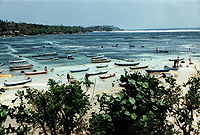Seaweed
| Seaweed Informal group of macroscopic marine algae
| |
|---|---|
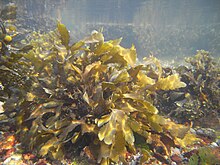
| |
| Fucus serratus | |
| Scientific classification | |
| Domain: | Eukaryota |
| Seaweeds can be found in the following groups | |
| |
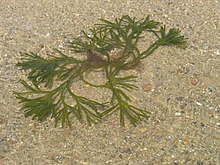

Seaweed, or macroalgae, refers to thousands of species of
Natural seaweed ecosystems are sometimes under threat from human activity. For example, mechanical
Humans have a long history of cultivating seaweeds for their uses. In recent years,
Taxonomy
"Seaweed" lacks a formal definition, but seaweed generally lives in the ocean and is visible to the naked eye. The term refers to both flowering plants submerged in the ocean, like eelgrass, as well as larger marine algae. Generally, it is one of several groups of multicellular algae; red, green and brown.[7] They lack one common multicellular ancestor, forming a polyphyletic group. In addition, blue-green algae (Cyanobacteria) are occasionally considered in seaweed literature.[8]
The number of seaweed species is still a topic of discussed among scientists, but it is most likely that there are several thousand species of seaweed.[9]
Genera

The following table lists a very few example genera of seaweed.
| Genus | Algae Phylum |
Remarks | |
|---|---|---|---|
| Caulerpa | 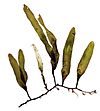 |
Green | Submerged. |
| Fucus | 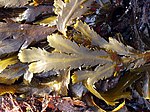 |
Brown | In intertidal zones on rocky shores. |
| Gracilaria | 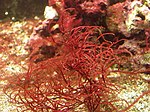 |
Red | Cultivated for food. |
| Laminaria |  |
Brown | Also known as kelp 8–30 m under water and cultivated for food. |
| Macrocystis |  |
Brown | Giant kelp forming floating canopies. |
| Monostroma | 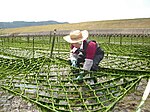 |
Green | |
| Porphyra |  |
Red | Intertidal zones in temperate climate and cultivated for food. |
| Sargassum | 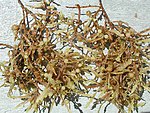 |
Brown | Pelagic especially in the Sargasso Sea. |
Anatomy
Seaweed's appearance resembles non-woody terrestrial plants. Its anatomy includes:[10][11]
- Thallus: algal body
- Lamina or blade: flattened structure that is somewhat leaf-like
- Sorus: spore cluster
- pneumatocyst, air bladder: a flotation-assisting organ on the blade
- Kelp, float: a flotation-assisting organ between the lamina and stipe
- Stipe: stem-like structure, may be absent
- Holdfast: basal structure providing attachment to a substrate
- Lamina or blade: flattened structure that is somewhat leaf-like
The stipe and blade are collectively known as the frond.
Ecology

Two environmental requirements dominate seaweed
Seaweed occupies various ecological niches. At the surface, they are only wetted by the tops of sea spray, while some species may attach to a substrate several meters deep. In some areas, littoral seaweed colonies can extend miles out to sea.[12] The deepest living seaweed are some species of red algae. Others have adapted to live in tidal rock pools. In this habitat, seaweed must withstand rapidly changing temperature and salinity and occasional drying.[13]
Macroalgae and macroalgal detritus have also been shown to be an important food source for benthic organisms, because macroalgae shed old
As macroalgae takes up
Biogeographic expansion
Nowadays a number of vectors - e.g., transport on ship hulls, exchanges among shellfish farmers, global warming, opening of trans-oceanic canals - all combine to enhance the transfer of exotic seaweeds to new environments. Since the piercing of the Suez Canal, the situation is particularly acute in the Mediterranean Sea, a 'marine biodiversity hotspot' that now registers over 120 newly introduced seaweed species -the largest number in the world.[20]
Production
As of 2019, 35,818,961 tonnes were produced, of which 97.38% were produced in Asian countries.[21]
| Country | tonns per year, cultured and wild |
|---|---|
| China | 20,351,442 |
| Indonesia | 9,962,900 |
| South Korea | 1,821,475 |
| Philippines | 1,500,326 |
| North Korea | 603,000 |
| Chile | 427,508 |
| Japan | 412,300 |
| Malaysia | 188,110 |
| Norway | 163,197 |
| United Republic of Tanzania | 106,069 |
Farming
Seaweed farming or kelp farming is the practice of cultivating and harvesting seaweed. In its simplest form farmers gather from natural beds, while at the other extreme farmers fully control the crop's life cycle.
The seven most cultivated
The largest seaweed-producing countries as of 2022 are China (58.62%) and Indonesia (28.6%); followed by South Korea (5.09%) and the Philippines (4.19%). Other notable producers include North Korea (1.6%), Japan (1.15%), Malaysia (0.53%), Zanzibar (Tanzania, 0.5%), and Chile (0.3%).[24][25] Seaweed farming has frequently been developed to improve economic conditions and to reduce fishing pressure.[26]
The Food and Agriculture Organization (FAO), reported that world production in 2019 was over 35 million tonnes. North America produced some 23,000 tonnes of wet seaweed. Alaska, Maine, France, and Norway each more than doubled their seaweed production since 2018. As of 2019, seaweed represented 30% of marine aquaculture.[27]
Seaweed farming is aUses
Seaweed has a variety of uses, for which it is farmed[31] or foraged.[32]
Food
Seaweed is consumed across the world, particularly in
Seaweeds are used as animal feeds. They have long been grazed by sheep, horses and cattle in Northern Europe, even though their nutritional benefits are questionable. Their protein content is low and their heavy metal content is high, especially for arsenic and iodine, which are respectively toxic and nutritious.[37][38]
They are valued for fish production.[39] Adding seaweed to livestock feed can substantially reduce methane emissions from cattle,[40] but only from their feedlot emissions. As of 2021, feedlot emissions account for 11% of overall emissions from cattle. [41]
Medicine and herbs
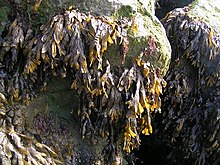

Alginates are used in wound dressings (see alginate dressing), and dental moulds. In microbiology, agar is used as a culture medium. Carrageenans, alginates and agaroses, with other macroalgal polysaccharides, have biomedicine applications. Delisea pulchra may interfere with bacterial colonization.[42] Sulfated saccharides from red and green algae inhibit some DNA and RNA-enveloped viruses.[43]
Seaweed extract is used in some diet pills.
Climate change mitigation
Other uses
Other seaweed may be used as
Seaweed is under consideration as a potential source of
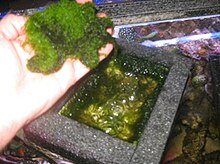
Alginates are used in industrial products such as paper coatings, adhesives, dyes, gels, explosives and in processes such as paper sizing, textile printing, hydro-mulching and drilling. Seaweed is an ingredient in toothpaste, cosmetics and paints. Seaweed is used for the production of bio yarn (a textile).[58]
Several of these resources can be obtained from seaweed through biorefining.
Seaweed collecting is the process of collecting, drying and pressing seaweed. It was a popular pastime in the Victorian era and remains a hobby today. In some emerging countries, seaweed is harvested daily to support communities.

Seaweed is sometimes used to build roofs on houses on Læsø in Denmark[59]
-
Laverbread and toast
-
Small plots being used to farm seaweed in Indonesia, with each rectangle belonging to a different family
Health risks
Rotting seaweed is a potent source of hydrogen sulfide, a highly toxic gas, and has been implicated in some incidents of apparent hydrogen-sulphide poisoning.[60] It can cause vomiting and diarrhea.[61]
The so-called "stinging seaweed"
Threats
Bacterial disease ice-ice infects Kappaphycus (red seaweed), turning its branches white. The disease caused heavy crop losses in the Philippines, Tanzania and Mozambique.[63]
Sea urchin barrens have replaced kelp forests in multiple areas. They are "almost immune to starvation". Lifespans can exceed 50 years. When stressed by hunger, their jaws and teeth enlarge, and they form "fronts" and hunt for food collectively.[63]
See also
- Algaculture – Aquaculture involving the farming of algae
- Seaweed fertilizer
- Algae fuel – Use of algae as a source of energy-rich oils
- Edible seaweed – Algae that can be eaten and used for culinary purposes
- Aonori – Type of edible green seaweed
- Cochayuyo – Species of seaweed, a form of kelp used as a vegetable in Chile
- Hijiki – Species of seaweed
- Kombu – Edible kelp
- Limu
- Mozuku – Species of seaweed
- Nori – Edible seaweed species of the red algae genus Pyropia
- Ogonori – Genus of seaweeds
- Wakame – Species of seaweed
- Marine permaculture
- Sea lettuce – Genus of seaweeds
- Seaweed cultivator – machine that grows and harvests seaweed
- Seaweed dermatitis – Species of bacterium
- Seaweed toxins
References
- ^ a b "Escharotic stomatitis caused by the "stinging seaweed" Microcoleus lyngbyaceus (formerly Lyngbya majuscula): case report and literature review".
- ISBN 978-0-7216-2921-6.
- ^ "How much oxygen comes from the ocean?". National Ocean Service. National Oceanic and Atmospheric Administration. Retrieved 23 November 2021.
- ^ "California's crashing kelp forest". phys.org. Retrieved 2021-02-24.
- ISSN 2296-7745.
- ^ Bindoff, N. L.; Cheung, W. W. L.; Kairo, J. G.; Arístegui, J.; et al. (2019). "Chapter 5: Changing Ocean, Marine Ecosystems, and Dependent Communities" (PDF). IPCC Special Report on the Ocean and Cryosphere in a Changing Climate. pp. 447–587.
- ^ "5.4: Algae". Biology LibreTexts. 2019-06-15. Retrieved 2024-02-10.
- ISBN 9780521408974.
- ISBN 9780878936021.
- ^ "seaweed menu". www.easterncapescubadiving.co.za. Archived from the original on 2020-02-17. Retrieved 2019-04-28.
- ^ "The Science of Seaweeds". American Scientist. 2017-02-06. Retrieved 2022-06-02.
- ^ Campbell, Joshua (4 April 2022). "Significance of Seaweeds in Improving the Aquatic and Terrestrial Environment" (PDF). Journal of Aquaculture Research & Development. 13 (3): 1 – via Walsh Medical Media.
- ^ Lewis, J. R. 1964. The Ecology of Rocky Shores. The English Universities Press Ltd.
- ^ doi:10.1038/ngeo2790..
- S2CID 84714929.
- ^ S2CID 10417856.
- . Retrieved September 21, 2020.
- PMID 29925564.
- S2CID 199448971.
- ISBN 9789299000342.
- ^ Global seaweeds and microalgae production(FAO)
- ^ PMID 35820048.
- ^ "Seaweeds: Plants or Algae?". Point Reyes National Seashore Association. Retrieved 1 December 2018.
- .
- S2CID 53640917.
- ^ Ask, E.I (1990). Cottonii and Spinosum Cultivation Handbook. Philippines: FMC BioPolymer Corporation. p. 52.
- ^ a b Jones, Nicola (March 15, 2023). "Banking on the Seaweed Rush". Hakai Magazine. Retrieved 2023-03-19.
- doi:10.2172/1874372.
- ^ ISSN 2296-7745.
- ^ a b Bindoff, N. L.; Cheung, W. W. L.; Kairo, J. G.; Arístegui, J.; et al. (2019). "Chapter 5: Changing Ocean, Marine Ecosystems, and Dependent Communities" (PDF). IPCC Special Report on the Ocean and Cryosphere in a Changing Climate. pp. 447–587.
- Sun.Star. 2008-06-19. Archived from the originalon 2008-09-09. Retrieved 2008-07-16.
- ^ "Springtime's foraging treats". The Guardian. London. 2007-01-06. Retrieved 2008-07-16.
- ^ Mohammad, Salma (4 Jan 2020). "Application of seaweed (Kappaphycus alvarezii) in Malaysian food products". International Food Research Journal. 26: 1677–1687.
- ^ "Devon Family Friendly – Tasty Seaweed Recipe – Honest!". BBC. 2005-05-25. Retrieved 2012-06-28.
- ^ Adriano, Leilanie G. (21 December 2005). "'Gamet' sushi festival launched". The Manila Times. Retrieved 15 August 2021.
- ^ Round F. E. 1962 The Biology of the Algae. Edward Arnold Ltd.
- .
- PMID 24700148.
- ^ Heuzé V., Tran G., Giger-Reverdin S., Lessire M., Lebas F., 2017. Seaweeds (marine macroalgae). Feedipedia, a programme by INRA, CIRAD, AFZ and FAO. https://www.feedipedia.org/node/78 Last updated on May 29, 2017, 16:46
- ^ "Seaweed shown to reduce 99% methane from cattle". irishtimes.com. Retrieved 9 April 2018.
- ISSN 1059-1028. Retrieved 2023-12-30.
- PMID 18065627.
- .
- PMID 15896707.
- ^ "New Seaweed Pill Works Like Gastric Banding". Fox News. 25 March 2015.
- ^ Elena Gorgan (6 January 2009). "Appesat, the Seaweed Diet Pill that Expands in the Stomach". softpedia.
- ISSN 2296-7745.
- ^ Temple, James (2021-09-19). "Companies hoping to grow carbon-sucking kelp may be rushing ahead of the science". MIT Technology Review. Retrieved 2021-11-25.
- ISSN 1557-7015.
- PMID 30464260.
- PMID 29925564.
- )
- S2CID 98479418.
- ^ Buck, Holly Jean (April 23, 2019). "The desperate race to cool the ocean before it's too late". MIT Technology Review. Retrieved 2019-04-28.
- South Florida Sun-Sentinel. Retrieved 2012-04-11.[permanent dead link]
- ^ "Seaweed Power: Ireland Taps New Energy Source". alotofyada.blogspot.co.uk. 2008-06-24. Retrieved 9 April 2018.
- .
- ^ "The promise of Bioyarn from AlgiKnit". MaterialDriven.[permanent dead link]
- ^ "Seaweed Thatch". naturalhomes.org. Retrieved 9 April 2018.
- ^ "Algues vertes: la famille du chauffeur décédé porte plainte contre X" [Green algae: the family of the deceased driver files a complaint against X] (in French). Saint-Brieuc: AFP. 2010-04-22. Archived from the original on 2014-02-24. Retrieved 2010-04-22 – via Google News.
- ^ Contaminants, National Research Council (US) Committee on Emergency and Continuous Exposure Guidance Levels for Selected Submarine (2009), "Hydrogen Sulfide", Emergency and Continuous Exposure Guidance Levels for Selected Submarine Contaminants: Volume 3, National Academies Press (US), retrieved 2024-02-10
- S2CID 22375739.
- ^ a b Buck, Holly Jean (April 23, 2019). "The desperate race to cool the ocean before it's too late". MIT Technology Review. Retrieved 2019-04-28.
Further reading
- Iselin, Josie. An Ocean Garden: The Secret Life of Seaweed (Oregon State University Press, 2023) online book review
- Wiencke, Christian, Kai Bischof (ed.) Seaweed Biology: Novel Insights into Ecophysiology, Ecology & Utilization. Springer (2012). ISBN 978-3-642-28451-9(eBook).
External links
- Michael Guiry's Seaweed Site information on all aspects of algae, seaweed and marine algal biology
- SeaweedAfrica, information on seaweed utilisation for the African continent.
- Seaweed. A chemical industry in Brittany, in the past and today.
- AlgaeBase, a searchable taxonomic, image, and utilization database of freshwater, marine and terrestrial algae, including seaweed.



